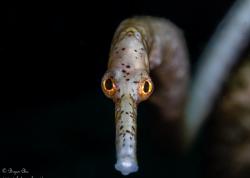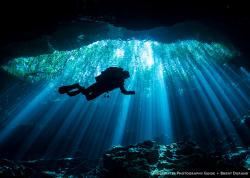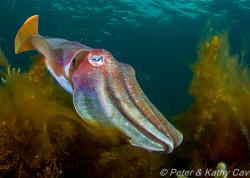Macro Surprises at the Blue Heron Bridge
Macro Surprises at the Blue Heron Bridge
Incredible Macro Photo Opportunities Await Divers at this Florida Hotspot
Text and Photos By Suzan Meldonian

Sinking into the water, the treasure hunt begins. For so many, the Blue Heron Bridge dive has become our “Secret Bay” of the USA. The BHB is well established now as a world class muck dive, and home of the questionable “Muck Monster,” whom anyone has yet to see. It is a place where you can see anything and everything. For the uw macro photographer, it is a treasure trove boasting a host of the odd and the unusual.
At first glance, to the untrained eye, the underwater terrain at the Blue Heron Bridge does not breathe as a beautiful reef with flowing purple sea fans that Florida is so well known for. Instead it looks like . . . sand and rubble or fields of hairy brown algae. A friend once said, “wow, it looks like a nuclear wasteland.” But it is far, far from that. We have things here you could wait your entire life to see.
Quickly you realize that you must train your eyes to hunt for specific movement. When I say hunt, I mean look. “Think small, look but don’t touch, and above all DO NOT TAKE.” Many of us have spent years trying to raise awareness and make this a No Take Zone, because after all is said and done, it is an underwater nursery. Words like “Cute” and “exotic” just barely scratch the surface of what you may see all in one dive.
Funky Frogfish and Batfish that look like something out of an alien comic book, Bobbit worms and Blue Throat Pike Blennies are just a few of the unusual critters you can find here. It is not uncommon to see Jawfish with eggs, we’ve even encountered a Golden Mantis of all the crazy things you could possibly find in Florida. Over the last several years, we’ve discovered two types of Stargazers, 8 types of sea robins, over 100 different nudibranchs, and a plethora of migrations occurring at monthly intervals and of course our rare and treasured seahorses. It is indeed a nursery. Per Rob Myers, author of Micronesian Reef Fish, “often you will never see the adults.”

One of my first encounters with weird looking animals at the bridge was with the Polka dot Batfish. From above they are almost undetectable blending in with their surroundings. In addition to the Polka dot batfish, we’ve come across the Roughback and the Shortnose Batfish as well. These creatures with the face that only a mother can love are also equipped with a lure that protrudes from their forehead. This probiscus stays in recession except when they are fishing. It is not very long with two flaps and resembles Fred Flintone’s fingers. You must remain perfectly still and pose absolutely no threat for them to display the lure. They are quite adept at turning their face away from you, and while they use their “feet” to lift off, they can take off and swim quickly away.

The Bobbitt worms at the BHB will accept algae and or Calerpa being hand fed to them. They are different than other types of Bobbit worms that we see online as the mandibles are not visible, and in this image, they are actually kind of cute. Usually only seen out at night, if photographed with a red light, a small tiny head like this will continue to come out of its burrow until it is nearly two feet long! Also very skittish. You cannot move a muscle when trying to photograph them.

The Blue Throat Pike Blenny is another silent singer. Easily missed unless you are really looking for them, can appear as thin as a pencil and really blend in well with their surroundings . . . until they decide to sing. Then they expand that gullet larger than three times their girth. I often imagine that there is a whole sound thing happening there that our ears are simply not able to hone in on. With all the traffic on the reef, I often wonder if it sounds like downtown New York to them.
Marine Life at the Blue Heron Bridge
The key to this place is to take it slow. Take advantage of the shallow depth by studying your subject face to face. Don’t forget to bring your 10x or 5x diopter, because that just peels back a whole new layer of subjects. If you want to get really good shots, you need to hunker down with your subjects, take the time to feel the connection and wait for the right moment. That’s the beauty here.
Recently, several Pipehorses were spotted. Honestly, one would have been exciting. The only place I’ve ever seen a pipehorse was in the Philippines. But right here in our own back yard - big wow! They were just passing through for a little migration therapy. Even more spectacular than that was when over 50 golden cow nosed rays came in like a herd of elephants and circumnavigated divers in just five feet of water. It’s a giggly moment for anyone. We’ve even had events of spiraling Jacks with the Spotted Eagle Rays playing dodgeball through the center trying to confuse the Jacks. That’s amazing to watch, and you just have to be in the center of that spiro-gyro moment to fully appreciate the encounter.

Pipehorse, a cross between a Pipefish and a Seahorse, are a very rare find at the Blue Heron Bridge. They are very small, but not so thin as the ones in the Philippine Sea.
Every October right around Halloween, the Spotted Eagle Rays come in for a meet ‘n greet by the pilings. Usually the females arrive first, then one tremendous male with a wingspan of perhaps ten feet comes in to join the harem. They are quite skittish to human approach. It is possible to photograph them with a 60mm, but not easy. Imagine yourself being in ten to twenty feet of water, all set up for macro, and here comes a school of Spotted Eagle Rays, flanked by juvenile Mobula Rays, or better yet, how about a big oafy Manatee! But then the cute happens, as one baby Mobula breaks formation and comes right up to you, face to face - practically gives you raspberries - does a 180, then darts off into the blue so close you hear the snap of its wing. It’s a Disney moment for sure. By the time you grasp what just happened, you realize, you forgot to push the shutter button. You find yourself smiling anyway because it was just way too cool and it happened at the Blue Heron Bridge!

The Spotted Eagle Rays show up in numbers around Halloween and stay until perhaps February. Some remain on as residents, but the rest of the crew take off until next year. The troupe seems to consist of a harem style of social grouping with one really large male, and several “ladies-in-waiting” who follow him around all day. This year the flock picked up some hitchhiker juvenile Mobulas, which got everyone excited. As one of my friends always says, “bestill my heart, I saw a Spotted Eagle Ray today.” I think all the divers at Blue Heron resonate this sentiment. It almost feels like an omen of good luck to see these graceful animals glide by and even more exciting if they don’t bank left upon the sight of human. But every great once in a while, one gets a l i t t l e curious. They are truly rebreather material.
Diving the BHB
Located inside the Intra-Coastal Waterway, the access to the ocean is through the Lake Worth Inlet, which unites with the Gulf Stream Current. This current is like the super highway for marine life on the east coast. The tidal flow between the Blue Heron Bridge and the GSC is the magic transport bringing in some of the most amazing animals on the planet. However, the currents can be too intense before and after slack tide. Divers must be clear to avoid the tidal pull once slack tide is over. Therefore dive time in is 1 hour before slack tide, no fooling around. New visitors to the bridge should consider hiring a dive guide from one of the local dive shops - or dive with someone who frequents the Bridge.
The diving area borders a small beach at the Phil Foster Recreational Park. With a depth under twenty five feet, you can get up to a two hour dive, if the visibility and tidal current change permit it. With a diving area the size of two football fields, you need at least 4 days to see everything. Each area has its special resident critters. Examples include Nudi World, where nudibranchs like Elysia ornata and Lucayan plocamorpherus can be found, and Blenny Flats where dueling Sailfin blennies and singing Pike Blennies reside. There are over 5 wrecks and out in front of the lifeguard station is the artificial reef that spans the beach, teaming with new life. The best part is that it is open year round and the water temperature rarely goes below 70°.
See you . . . Under the Bridge!

Perhaps one of the most treasured finds at the Blue Heron Bridge are the seahorses. Such a fragile and delicate creature, they are highly reactive to over photographing. So the word is, if you find one, sit tight and wait for that “moment,” rather than snapping one shot after another. They normally are quite shy, and will turn away from your lens and from your flashing. It just takes a bit of patience. If they lay down, they are stressing or you’ve gotten too close. Be kind and take a breath to observe their intricate beauty. More importantly is to keep an eye out for divers with shloosh guns (a device used to suck up the seahorses). Wait for them to move along. Wild seahorses don’t live long in captivity.

Ahh Blennies. They are always a source of entertainment and smiles. They really display so many different expressions, probably more so than any other fish in the area. On bad viz days I find myself hunting for them just to have a laugh. Very curious this baby Seaweed Blenny, who was no bigger than my pinkie finger, has made the face for me.
Further Reading
-
Jupiter by Surprise - Sharks, Macro & Groupers in Florida
-
The Photographer's Guide to Muck Diving
-
Choosing a Macro Lens for Underwater Photography
About the Author
Suzan Meldonian is the author of Under the Bridge and the BHB Companion - both photo ID books on the unusual marine life found at the Blue Heron Bridge, Florida. She will be a guest speaker at ADEX in April 2015. You can view her work at www.niteflightphoto.com
Support the Underwater Photography Guide:
The Best Service & Prices on u/w Photo Gear
 Visit Bluewater Photo & Video for all your underwater photography and video gear. Click, or call the team at (310) 633-5052 for expert advice!
Visit Bluewater Photo & Video for all your underwater photography and video gear. Click, or call the team at (310) 633-5052 for expert advice!
The Best Pricing, Service & Expert Advice to Book your Dive Trips
 Bluewater Travel is your full-service scuba travel agency. Let our expert advisers plan and book your next dive vacation. Run by divers, for divers.
Bluewater Travel is your full-service scuba travel agency. Let our expert advisers plan and book your next dive vacation. Run by divers, for divers.
RECOMMENDED ARTICLES
SUPPORT THE UNDERWATER PHOTOGRAPHY GUIDE:
The Best Service & Prices on u/w Photo Gear
 Visit Bluewater Photo & Video for all your underwater photography and video gear. Click, or call the team at (310) 633-5052 for expert advice!
Visit Bluewater Photo & Video for all your underwater photography and video gear. Click, or call the team at (310) 633-5052 for expert advice!
The Best Pricing, Service & Expert Advice to Book your Dive Trips
 Bluewater Travel is your full-service scuba travel agency. Let our expert advisers plan and book your next dive vacation. Run by divers, for divers.
Bluewater Travel is your full-service scuba travel agency. Let our expert advisers plan and book your next dive vacation. Run by divers, for divers.































